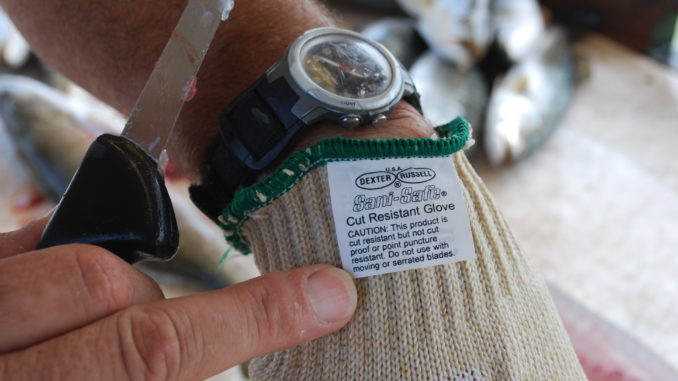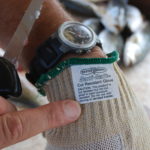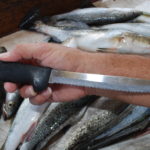
The Slimeslinger travels light, with all his tools in a single plastic tool box. Naturally enough, the man’s most important tools are his knives. He only carries three kinds, and none of them are the scimitar that one would imagine that he would need to clean a 100-pound tuna.
Most used is an F. Dick Stiff Boning Blade Knife, model number 3990-15. This is the knife used to make all filleting cuts on a fish, no matter how large the fish. Richoux is prone to make his cuts shallow on the first pass, and then come back and make them deeper, so he can clean the largest fish with a 6-inch blade.
Next most used is his F. Dick Flex Knife, model number 8 2981 15, also 6 inches long. The metal in the blade of this knife is much thinner and the blade is much more flexible. This is the knife he uses to knock the skin off the fillets.
Both knives are made of surgical steel, he explains, the same thing as is in scalpels. Stamped on the blades are the words “high carbon,” but they don’t stain or rust.
Neither of these knives can be purchased locally, says Richoux, who orders his from I&L Specialty Cutlery in Sarasota, Fla.
“Ask for Larry Cohen,” advises Richoux, as if referring to a neighbor. “I get 4 or 5 years out of an F. Dick knife,” he adds, “unless I hit a nail or drop it overboard.”
The third knife is a wicked-looking, serrated Dexter Russell 8-inch Tiger Edge Utility Knife, model number SG142/8TE. These, which he calls “shark-tooth knives,” are purchased from Richard’s Restaurant Supply Inc., in Houma.
This knife is used for cutting hard-boned fish rib cages, cleaning sharks and for steaking mackerel. It is also the knife that he turns to for removing snapper throats, one of his favorite delicacies.
The tool box holds two sharpening steels, one a medium steel and the other a finishing steel.
“Never sharpen a knife on a stone — always use a steel,” he directs as much as explains. “I don’t use a knife until it gets dull.”
Richoux uses one piece of protective gear to reduce the risk of cuts from the sharp cutlery, a Dexter Russell Sani-Safe Cut Resistant Glove on the hand opposite the one handling the knife. These he purchases at Richard’s as well, but he admits that they are available elsewhere.
Finally, he carries a supply of zipper-style plastic bags and an indelible marker to write the name of the fish on the bags.




